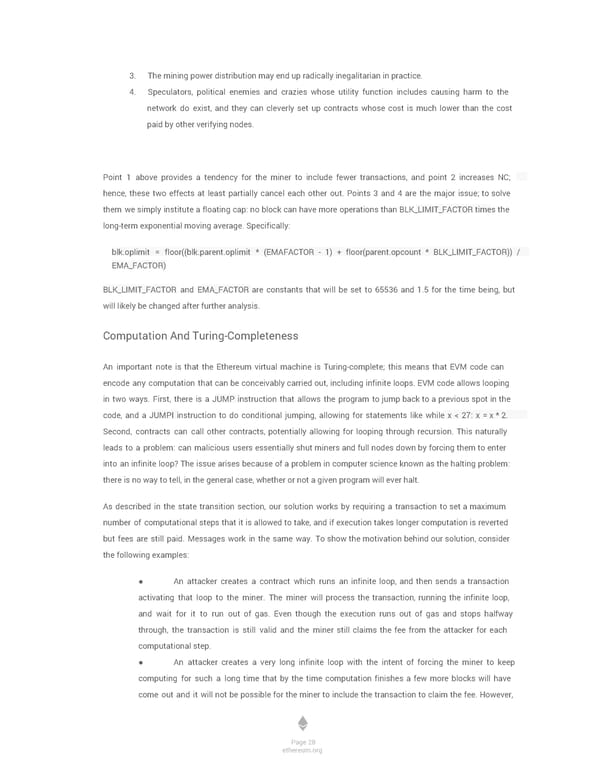3. The mining power distribution may end up radically inegalitarian in practice. 4. Speculators, political enemies and crazies whose utility function includes causing harm to the network do exist, and they can cleverly set up contracts whose cost is much lower than the cost paid by other verifying nodes. Point 1 above provides a tendency for the miner to include fewer transactions, and point 2 increases NC; hence, these two effects at least partially cancel each other out. Points 3 and 4 are the major issue; to solve them we simply institute a floating cap: no block can have more operations than BLK_LIMIT_FACTOR times the long-term exponential moving average. Specifically: blk.oplimit = floor((blk.parent.oplimit * (EMAFACTOR - 1) + floor(parent.opcount * BLK_LIMIT_FACTOR)) / EMA_FACTOR) BLK_LIMIT_FACTOR and EMA_FACTOR are constants that will be set to 65536 and 1.5 for the time being, but will likely be changed after further analysis. Computation And Turing-Completeness An important note is that the Ethereum virtual machine is Turing-complete; this means that EVM code can encode any computation that can be conceivably carried out, including infinite loops. EVM code allows looping in two ways. First, there is a JUMP instruction that allows the program to jump back to a previous spot in the code, and a JUMPI instruction to do conditional jumping, allowing for statements like while x < 27: x = x * 2. Second, contracts can call other contracts, potentially allowing for looping through recursion. This naturally leads to a problem: can malicious users essentially shut miners and full nodes down by forcing them to enter into an infinite loop? The issue arises because of a problem in computer science known as the halting problem: there is no way to tell, in the general case, whether or not a given program will ever halt. As described in the state transition section, our solution works by requiring a transaction to set a maximum number of computational steps that it is allowed to take, and if execution takes longer computation is reverted but fees are still paid. Messages work in the same way. To show the motivation behind our solution, consider the following examples: ● An attacker creates a contract which runs an infinite loop, and then sends a transaction activating that loop to the miner. The miner will process the transaction, running the infinite loop, and wait for it to run out of gas. Even though the execution runs out of gas and stops halfway through, the transaction is still valid and the miner still claims the fee from the attacker for each computational step. ● An attacker creates a very long infinite loop with the intent of forcing the miner to keep computing for such a long time that by the time computation finishes a few more blocks will have come out and it will not be possible for the miner to include the transaction to claim the fee. However, Page 28 ethereum.org
 Ethereum White Paper by Vitalik Buterin Page 31 Page 33
Ethereum White Paper by Vitalik Buterin Page 31 Page 33